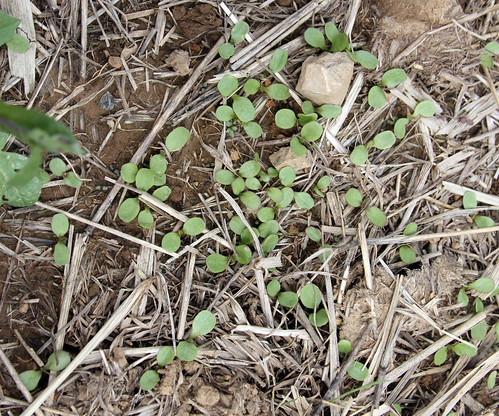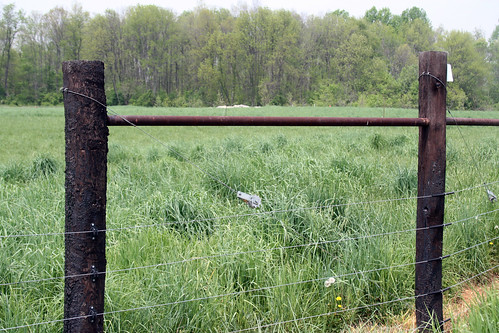 The pasture resource consists of 10 acres. There are five two-acre paddocks. Half of the test acreage is composed of orchardgrass and MaxQ tall fescue. The other five acres are being replanted this year.
The pasture resource consists of 10 acres. There are five two-acre paddocks. Half of the test acreage is composed of orchardgrass and MaxQ tall fescue. The other five acres are being replanted this year.
Our two acre field of chicory was being overwhelmed with thistle. Since we are unable to spray for thistle (the chemical would kill the chicory), we have replanted the chicory into another two acre paddock. It is beginning to come up. Chicory has several components that give it an "anthelmintic-like" effect. The goats "love" it. In place of the old chicory paddock will be pearl millet, a warm season annual grass that saved last year's test during the drought. Last year, the pearl millet was planted on the outside of the grazing system and had to be fenced in with electric netting. The goats don't seem to prefer the pearl millet, but they will eat it.
In place of the old chicory paddock will be pearl millet, a warm season annual grass that saved last year's test during the drought. Last year, the pearl millet was planted on the outside of the grazing system and had to be fenced in with electric netting. The goats don't seem to prefer the pearl millet, but they will eat it.
Another acre of orchardgrass had developed some disease problems. We are going to try forage kale in its place.
We have received nominations for more goats than we will be able to accomodate in the test. Though we could graze hundreds of goats now, we don't want to exceed our forage base during the summer when forage quality and quantity dimish or in the event of drought conditions. Maryland has experienced varying degrees of drought in each of the past three years. The nomination period closes on May 15. Preference will be given to previous consigners and Maryland residents. We will also give consideration to travel distances and arrangements. We will try to include as many consigners as possible. In the first two years of the test, we were unable to get 50 goats. We appreciate the support of this year's test.
The nomination period closes on May 15. Preference will be given to previous consigners and Maryland residents. We will also give consideration to travel distances and arrangements. We will try to include as many consigners as possible. In the first two years of the test, we were unable to get 50 goats. We appreciate the support of this year's test.
A field day and sale will be held on October 4 at the Washington County Agricultural Center (an ajacent property). Dr. Dan Waldron from Texas A&M University will be the featured speaker at the field day.











